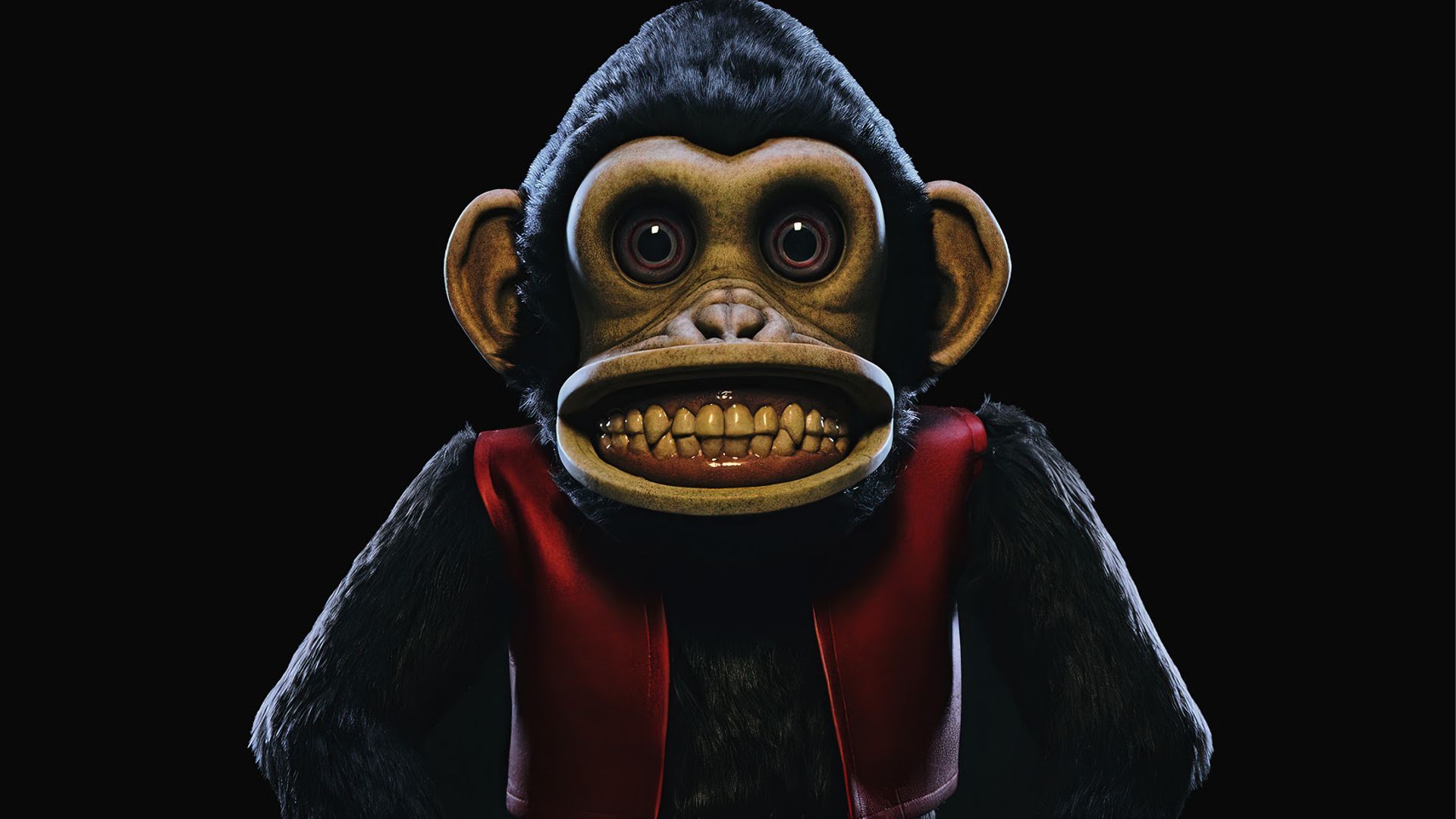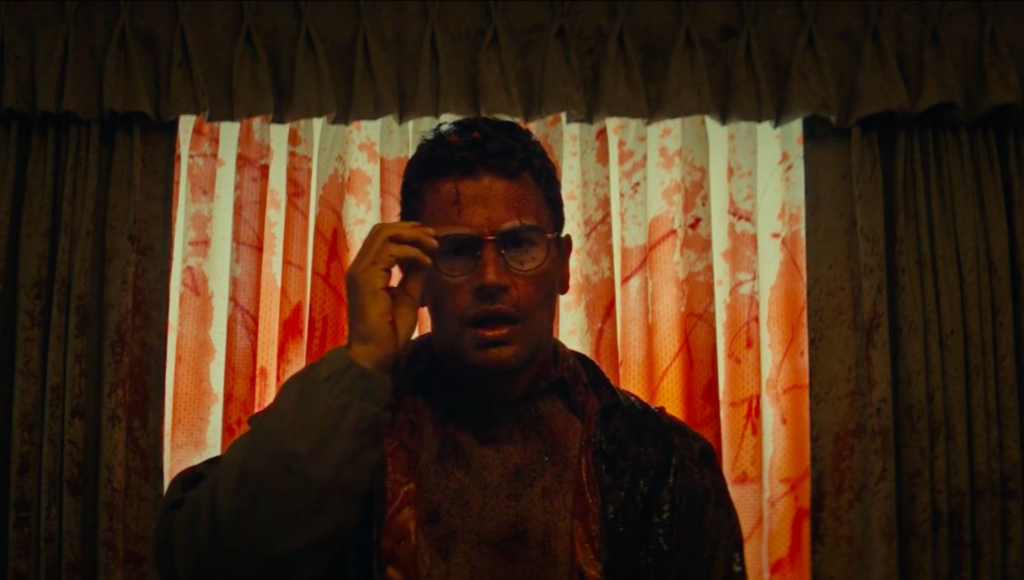
The Monkey
Mark White
There is always something horribly true about the stories written by Stephen King. Whether peering into the sewers of Derry for clowns and paper boats, hurtling through time for weeks at a time and contemplating saving a dead president, prisoners facing execution on ‘death row’ and witnessing strange things, or an entire town being encased in a giant dome in isolation from the rest of the country, King’s stories manage to deliver flawed, complex – even frustratingly raw, but painfully real – humanity. Perhaps that is the genuine genius to King’s works: very real people in extremely weird and terrifying nightmares (or fantasies) where the reality of life – its blind justices and indiscriminate punishments – can affect anyone, good or bad, without the safety net of a ‘happy ending’.
The Monkey – a King short story adaptation – revolves around Hal Shelburn (Theo James), a man who along with his identical twin Bill, has a long history with tragedy. As boys, Hal and Bill had to deal with the fact that their father abandoned them and their mother without any explanation – the old chestnut of ‘going out for cigarettes and never coming back’ being quite literally what happened. The boys’ mother Lois (Tatiana Maslany), ever so slightly bitter about being left alone but accepting of the fact that ‘that’s life’, tries to teach her sons that life is full of unfair, inexplicable things and that the best way to deal with that is to simply live – like choosing to dance on the day of a funeral…more on that image in a moment…
…because, quite randomly, the boys discover the eponymous monkey – a wind-up toy monkey that spins mounted drumsticks and plays an attached drum to the tune of some ominously cheerful organ-grinding – hidden among their absentee father’s belongings in a closet. Out of the box and freshly wound up, the monkey plays its drum…and the boys’ babysitter Anne is unexpectedly killed in outlandish fashion: decapitated in a Beni Hana-style restaurant…right on the tabletop grill…surrounded by patrons stuffing their faces. It is on the day of Anne’s funeral that Lois tells the boys the hard truth of life: ‘everybody dies and that sucks.’ She tells them that death is unavoidable, so you have to live life because you never know when or how death will come, hence dancing around the living room with the boys after Anne’s funeral.
But as it is with all horror films with inexplicably evil totems, the monkey’s function and association with Anne’s terrible death is evident to the boys – they wound up the toy after all – and they both seem to know that the monkey’s drumming brought Anne’s death. Now, meekish Hal and brutish Bill, as identical twin brothers go, are not fraternally very close and have a rather contemptible relationship that sees Bill leading other kids into bullying Hal at school. So when Hal winds the monkey on his own after a fresh humiliation at school, it is clear that he is expecting – rather hoping – something specific occurs when the monkey is done drumming. Only when the drumming stops, Lois is killed by a boomerang brain aneurysm while decorating a cake.
Grief stricken and riddled with guilt and confusion, Hal and Bill are taken in by their aunt and uncle, Chip and Ida. Bill, shaken by Lois’ death and traumatized by Anne’s death, is convinced that the monkey is responsible and decides to test the theory one last time by winding the toy and letting it drum, resulting in Chip being killed in a stampede while out hunting. Its evil abundantly made evident, the boys box up the monkey, wrap it in chains and drop it down a dry well so that it may never be used again.
Fast forward twenty-five years, and Hal – now an absentee father himself to his own son Petey – receives a call from Bill saying that their aunt Ida has just died…in a strange accident. And that there has been a slate of strange accidents in their adopted home town just shortly after the estate sale of Ida’s belongings. Bill is convinced that the monkey has been found and is being used again, and that he needs Hal to come home and help him find it and stop it, for good…
Osgood Perkins, fresh from the theatrical slam dunk that was LONG LEGS, takes the bare bones of King’s short story (first published in 1980) and fashions an adaptation that leans away from the heaviness – and the major plot of the original story – and embraces the universal, uncomfortable truth about societal attitudes towards death: there is a very fine line between humor and horror. Perkins is obliquely aware that horrendous injuries or terrible trauma can be very funny…unless one finds themselves to be the victim, then it is a ferocious nightmare.
Perkins has stated in several interviews while promoting the film that as a man who has had a several run-ins with meaningless death in his family, the idea of taking this King story and doing a straight adaptation bored him; he felt compelled to take the mechanic of the death-dealing monkey and underscore the futility of warding off or worrying about death because…it is the ultimate truth of life. Everyone WILL die at some point, and there is a bizarre relief – even a comedic comfort – in knowing that there is no ‘meaning’ in death other than being a quantified end to the biological process. Yes, some deaths are violent and some deaths are inflicted upon others, but the inevitability remains the same regardless of the time and place. And that remans the primary focus of Perkins’ film – everybody dies, and that sucks. But that’s life!
Everyone WILL die at some point, and there is a bizarre relief - even a comedic comfort - in knowing that there is no ‘meaning’ in death other than being a quantified end to the biological process.
What transpires on film is a series of unfortunate events (re: deaths) that play out each time that toy monkey beats its drum – and in the most outlandishly cartoon-like fashion imaginable. Picture the first seasons of South Park where Kenny died again and again: as the monkey plays, people are shredded, exploded, flattened, dismembered and – in the most outrageous death on the film – flambéed and sent running headfirst into a ‘for sale’ sign for impalement. The outrageous stunt work and practical effects are extreme, and meant to shock to the point of nervous tittering, or for the blackest of hearts, actual laughs (yours truly being guilty on more than one occasion). The intention here seems to be a showcase for the inexplicable nature of death that operates without favor or malice, simply picking victims at random and dispensing demise with whatever means are around as the moment calls for it.
But there is more going on under the blood spattering and organ music. Perkins’ story underscores ideas of trauma and grief in two key ways for Hal and Bill: the boys literally inherit death and mayhem from their father with the cursed monkey in his possessions; and the boys literally set the course of their lives and their eventual confrontation with the monkey – and each other – in trying to ‘control’ and use death and end up killing people they love. These plot points act as a commentary on generational trauma and grief, musing that mistakes and choices that other people make can literally be handed down to others right down the familial line. The parallel of an absentee father leaving this cursed thing for his boys is on the nose, but when paired with the fact that Hal himself becomes an absentee father because of the family curse of the monkey, it becomes clear that Perkins is leaning on an idea of how some things define families that are bigger than simply life or death, and that these can define a person. And then there is the use of the monkey, not simply as a conduit of death, but the fact that it cannot be controlled; Hal’s emotional choice to use it as an act of revenge all those years ago shows not only Perkins’ reminding us that death has no conscience, but that trying to use death as a tool for any reason simply yields nothing but more trauma.

Frustratingly, these fascinating and complex ideas are often steamrolled over by a very sardonic bit of dialogue, or the next drum roll leading to yet another crazy death. James plays both brothers with a glib and dryly ironic sense of awareness that – on first viewing – does offer rather funny deadpan moments and delivers humor alongside the insanity happening on screen, but that ultimately becomes something of a shortcoming. In fact, snarky and glib is the best way to describe every character in this film; the tone offers dark humor and insight, but it persistent and emotionally unyielding. The sarcastic and and blasé self awareness all take away from any expected ‘horror’ in the wild deaths that happen, so much so that it begins to take the knee-jerk shocks of the mayhem and dull them over time, while making any of the characters involved – especially Hal and Bill – rather impossible to know much about, or to come to care for at all.
The production design is functional, with the obvious focus being spent on the gory special effects, and designing the simian totem at the center of the madness. The monkey is intricate and wonderfully detailed – capable of grinning OR smiling, eyed deeply set, and fully posable on camera. LONG LEGS editing duo Greg Ng and Graham Fortin re-team with Perkins to create wonderfully tense exchanges and set piece, and Nico Aguilar’s camerawork leads the eye around the frame for where the monkey may be hiding in the dark, or worse..for anything sharp or heavy that might just move and end someone’s life.
In the end, Perkins has taken literary liberty with a King classic short story and created a mean-spirited horror comedy that examines, trauma, death, and futility with grin and a morbid wink. But well-crafted and wicked as it is, a frustrating imbalance of deeper meanings and characterization against versus sardonic humor and extreme gore makes the film feel a little like…a toy drum. The Monkey has a good enough beat to enjoy – truly a devious, catchy beat – but rings a tiny bit hollow by the end.
Final Thought
Gleefully gory, giddily gonzo and ghoulishly (quite) good, Perkins’ adaptation of the Stephen King short has a grinning, grisly charm that genuinely grafts guffaws and gasps…and guts.
